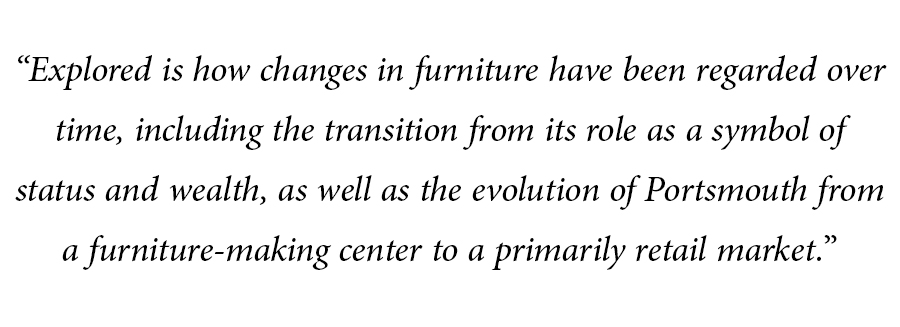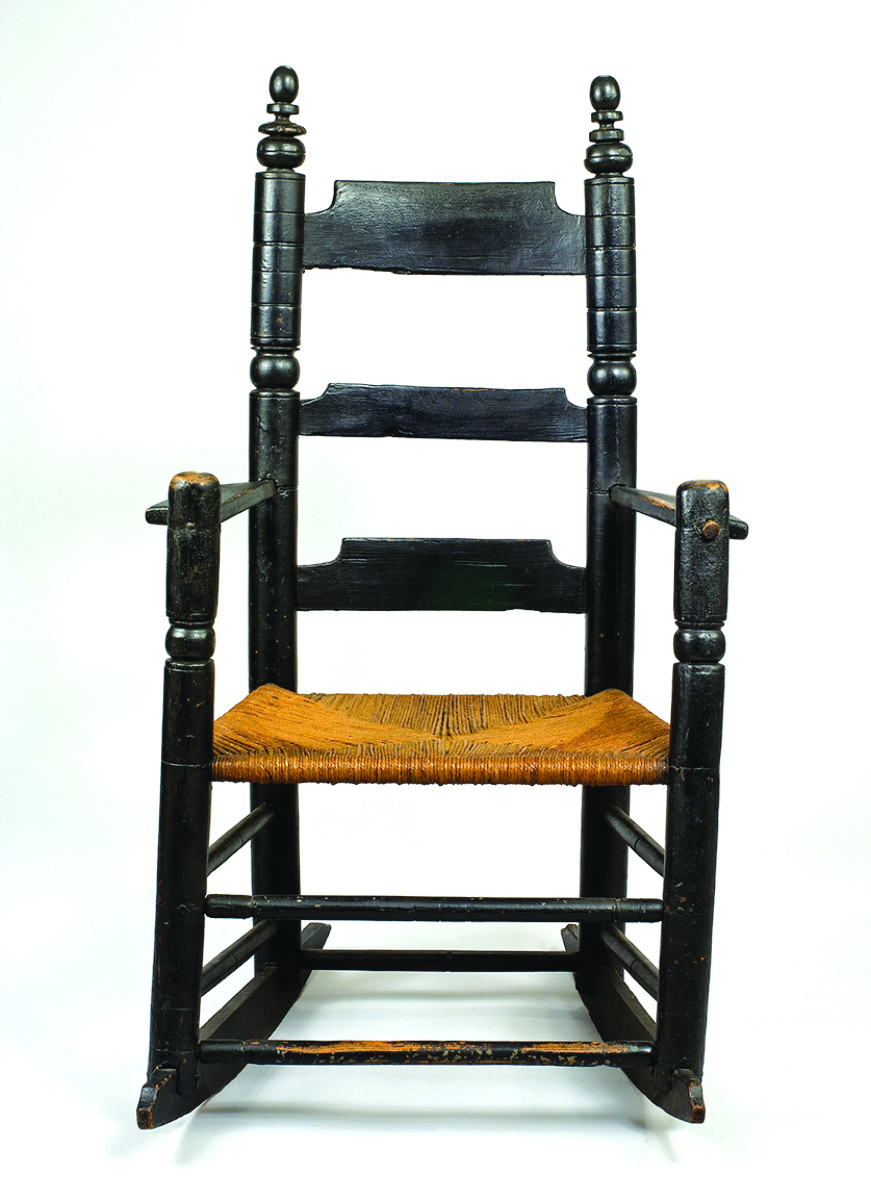
This is one of a small group of Neoclassical sideboards, circa 1815, including examples at Strawbery Banke Museum and the New Hampshire Historical Society, that can be attributed with a great deal of certainty to the prominent Portsmouth cabinetmaking partnership of Jonathan Judkins (1780–1844) and William Senter (1783–1827). Moffatt-Ladd House & Garden, museum purchase.
By Rick Russack
PORTSMOUTH, N.H. – The Portsmouth Historical Society (PHS) recently opened its spring exhibition, “Four Centuries of Furniture in Portsmouth.” Concurrently, the society has mounted an exhibition of the works of the New Hampshire Furniture Masters. Both exhibitions are on display at Discover Portsmouth and run through June 18.
The organizer of the exhibitions is Gerry Ward, consulting curator at the PHS. The loan exhibition of about 50 objects interprets the furniture made and used in Portsmouth, starting with the joined furniture of the Seventeenth Century, highlighting the Colonial and Federal periods of Portsmouth’s cabinetmaking, the revival style of the Nineteenth Century, as well as examples from the later Arts and Crafts and Studio Movements. Included is furniture used at the signing of the Portsmouth Peace Treaty, which ended the Russo-Japanese War, and examples of locally owned and retailed works of the Twentieth and Twenty-First Centuries – there is even an IKEA chair.
Explored is how changes in furniture have been regarded over time, including the transition from its role as a symbol of status and wealth, as well as the evolution of Portsmouth from a furniture-making center to a primarily retail market. Several of the objects on display have come to light since the seminal 1992 exhibition on the subject, titled “Portsmouth Furniture: Masterworks from the New Hampshire Seacoast,” organized by Brock Jobe and the Society for the Preservation of New England Antiquities (now known as Historic New England). Some of the great pieces that were featured in that earlier effort are also included. The PHS acknowledges its debt to Jobe and that earlier exhibition.
The time span of the 1992 exhibition has been extended by including objects made after 1825 and included are utilitarian, vernacular and even quirky objects. There is more emphasis on objects owned and used in Portsmouth, as well as those made there, reflecting the interests of the historical society. Material is drawn from several public and private collections, including objects owned by PHS, the Moffat-Ladd House in Portsmouth, the Warner House in Portsmouth, the Portsmouth Athenaeum, Strawbery Banke and the New Hampshire Historical Society.
 Several items have been loaned by local collectors, including Hollis Brodrick and Ron Bourgeault. The exhibition also includes paintings, prints, maps and smaller objects, as well as relevant historical documents. Some pieces are included because of the stories they tell, such as the two pieces once owned by an enslaved woman.
Several items have been loaned by local collectors, including Hollis Brodrick and Ron Bourgeault. The exhibition also includes paintings, prints, maps and smaller objects, as well as relevant historical documents. Some pieces are included because of the stories they tell, such as the two pieces once owned by an enslaved woman.
Portsmouth was settled in 1623, with early colonists involved in, and succeeding in, several fields – the timber trade, fisheries and shipbuilding, to name a few. The Piscataqua River forms the border between New Hampshire and Maine; the harbor it forms was the basis for its success and the region’s prosperity. The early maritime heart of the town was in the area of today’s Strawbery Banke museum. The town became the center of royal government, and several politically well-connected merchant families thrived through the 35 years (1741-1775) during which two members of the Wentworth family were royal governors. These elite families also shared membership in the Church of England chapel, originally named the “Queen’s Chapel” when it was built in 1732.
In 1765, when Robert Harrold, the town’s principal pre-Revolutionary War cabinetmaker, arrived, he found a busy seaport town and a prosperous community, at least for some. The wealthy and prosperous were building magnificent Georgian dwellings, such as the brick Archibald MacPheadris house built in 1716, and the John Langdon mansion built in 1784. These houses bracket this era, while the extraordinary house built by John Moffatt in 1761-63 stands in the middle of this period. The homes were often built by local contractors, many of whom had developed their skills in the shipbuilding trades. They were often furnished by local artisans, including Harrold, John Drew, Joseph Davis, John Gaines, Langley Boardman and the firm of Jonathan Judkins and William Senter, in styles that were reminiscent of, and sometimes hard to distinguish from, the work produced in Boston, Salem and other nearby towns.
Making chairs, not only for local customers but for export up and down the coast, as far away as Newfoundland and the Caribbean, was an important industry for local turners and chairmakers. Examples of their banister-back chairs and other forms are well represented in this exhibition. Also represented are several case pieces by the cabinetmakers mentioned above, along with some unusual items, such as a bathtub, nearly 6 feet long, that was carved from a single mahogany log.

When prominently featured in Portsmouth Furniture (pp 124–27, color plate 3 and the dust jacket), this important high chest was still in a private collection. The inlaid inscription in its pediment — “I + S / 1733” — suggests that the piece was owned by John Sherburne (1706–circa 1736), a merchant of Portsmouth, and made in 1733, which, in the words of Brock Jobe, make it “the earliest dated example of American furniture in the Queen Anne style” (Portsmouth Furniture, p 125). Warner House Association, gift of Ruth and Thaxter Swan.
Ward, in his introduction, writes, “Portsmouth furniture in the 1790 to 1820 period is a notable regional contribution to an American aesthetic. Although closely related to the furniture of eastern Massachusetts, Portsmouth furniture speaks with something of an individual accent, notable for its use in case furniture of striking color contrasts achieved through the skillful use of light and dark flitches of birch and mahogany veneers. Although many objects were imported, including fancy painted side chairs, Portsmouth remained a viable cabinetmaking center during a period of population growth (from 4,720 in 1790 to 7,320 in 1820). Fluctuating economic circumstances, as always, affected the market, and the era was punctuated by devastating downtown fires, particularly in 1813. These fires led to a substantial rebuilding in brick, and they may have led a substantial number of Portsmouth residents to brand their furniture for identification purposes. This practice presumably was helpful to the owners of the objects at the time and has proven to be an asset for modern furniture collectors and scholars seeking to identify local work.”
The scholarly catalog by Ward, Brodrick and PHS curatorial assistant Lainey McCartney includes an essay by Ward defining the exhibition and placing material in context. Each of the 50 items in the show is well described, and often included are concise histories of the local families that originally owned the objects. From 1999 to 2012, Ward served as the Weems senior curator of American decorative arts and sculpture at Boston’s Museum of Fine Arts, with responsibility for a collection of about 13,000 objects. Ward is now the curator emeritus of that collection. He is the author of several books on American furniture, as well as more than 70 articles on the American decorative arts, is the bibliographer and book review editor of American Furniture, the annual journal published by the Chipstone Foundation, and is the editor of the Decorative Arts Society newsletter.
He conducted one of the five programs that are being presented throughout the run of the exhibition. In April, with Brodrick, he presented “From Joiner to Cabinetmaker: Early Furniture from the Seacoast Area.” Remaining presentations include a May 18 lecture by Jobe, professor of American decorative arts emeritus, Winterthur Museum, Garden, and Library, and author of Portsmouth Furniture: Masterworks from the New Hampshire Seacoast. His talk is titled “Collecting Portsmouth Furniture within a Changing Marketplace.” Johanna McBrien, founding editor-in-chief of Antiques & Fine Art magazine, will present “Master and Apprentice: The Mystery of Who Trained Portsmouth Cabinetmaker Langley Boardman” on June 4, and on June 15, Bourgeault, president of Northeast Auctions, will present “Sixty Years of Antiquing in the Piscataqua Area.” Details on the talks are available at the website www.portsmouthhistory.org.

This turned great chair is one of the earliest objects in the exhibition, probably made in Boston or Charlestown, circa 1650–85. In all likelihood, it is one of the earliest surviving pieces of furniture with a continuous history in the greater Seacoast area. According to the research of Connie Hellwig, Bob Barth and Hollis Brodrick, this monumental armchair was probably owned originally by Robert Burnham (1615–1691), who settled in the Seacoast area about 1655. Private collection.
Concurrent with the downstairs exhibition, the upstairs gallery includes a display of works made by 15-20 members of the New Hampshire Furniture Masters (NHFMA), an elite group of woodworkers from throughout New England, including Jon Brooks, David Lamb, Richard Oedel, Jeffrey Cooper and others. This NHFMA display is accompanied by works in other media, and also includes examples of the NHFMA’s prison outreach program.
Founded in 1993, the NHFMA has grown to become an organization of some two dozen artists dedicated to the fine art of furniture making. The founding members, including craftsmen and community leaders, wished to “build public awareness of New Hampshire’s fine furniture makers and to cultivate an audience for their goods closer to home.” Although many of the masters are from the Granite state, others hail from other parts of New England. For them, “building furniture is not simply a job, it is a way of life.” Their outstanding work, known for its variety of traditional and innovative designs always expressed through excellent craftsmanship, is now in many museums and private collections. For more information, www.furnituremasters.org.
Discover Portsmouth Center is at 10 Middle Street. For information, 603-436-8433 or www.portsmouthhistory.org.
Rick Russack is a regular contributor to Antiques and The Arts Weekly. A history buff and retired book dealer, he lives in a 1760s house in New Hampshire with his rescue dog, Charlie.
Photos are by Ralph Morang unless otherwise noted and were provided by the Portsmouth Historical Society.




















